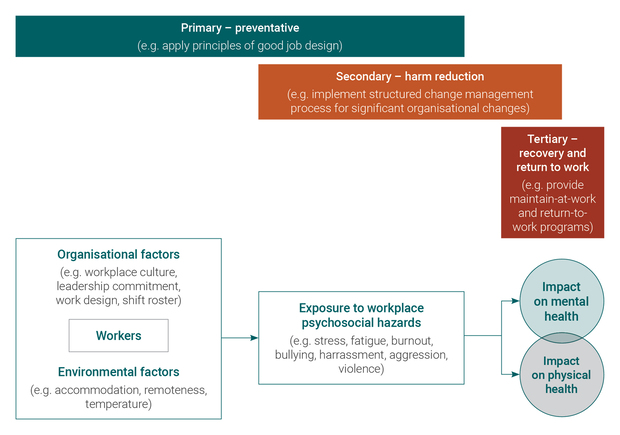
Types of control strategies
What is a primary control strategy?
Primary controls are aimed at the organisation and workforce. They are implemented before hazards or harm to health are present. They are the most effective control measures and should always be considered before anything else. Where it is not reasonably practicable to eliminate risks, the remaining risks are addressed by secondary and tertiary controls.
What is a secondary control strategy?
Secondary controls are implemented at the workforce level with the aim of intervening early to reduce harm to health (e.g. introduction of an employee counselling service, adjusting workloads).
When are tertiary control strategies used?
Tertiary controls are implemented if there has been harm to health. The aim is to restore or improve the worker’s mental health so they are able to return to work and a healthy state of functioning.
It is important that, so far as is reasonably practicable, workers returning to work from illness or injury are not exposed to psychosocial hazards and risk factors that may affect their recovery. A risk management approach helps prevent further harm, and supports successful return-to-work programs. Investment in the return-to-work process encourages early reporting, early intervention, and supports recovery.
Application of control strategies
Primary controls are the most effective and reliable form of control, followed by secondary and tertiary controls.
This diagram shows how psychosocial risk factors and exposure to psychosocial hazards can affect mental and physical health, and when organisations may apply control strategies to help establish and maintain mentally healthy workplaces.
Examples of controls
Enable workers to increase control over, and improve, their health
- Promote positive mental health and resilience and reduce stigma using a range of social and environmental actions (e.g. educational programs, policies, environmental improvements, campaigns, pre-employment information about work and living conditions for workers and families) to:
- create supportive environments that enhance healthy attitudes and skills, and destigmatise mental health conditions
- educate the workforce about what a mentally healthy workplace is and how they may contribute
- increase individual and organisational capacity to recognise and address mental health and wellbeing concerns
- raise awareness of the effect of alcohol and other drugs on mental health
Eliminate exposure to psychosocial hazards, so far as is reasonably practicable
- Address psychosocial hazards at their source by:
- applying principles of good job design (e.g. appropriate workload)
- providing education and training to organisational leaders on how they influence the development and maintenance of a mentally healthy workplace
- clearly defining job roles, reporting structures and activities
- establish achievable workloads and performance targets specific to the workplace’s current number of workers and skills mix
- promoting a workplace culture that is inclusive, destigmatises mental ill health and encourages help-seeking assistance
- developing and implementing policies and procedures that appropriately address psychosocial hazards and risk factors
- provide access to reliable communication technology
Reduce likelihood and severity of harm from exposure to psychosocial hazards and risk factors
Minimise harm by:
- educating organisational leaders on intervention strategies and how they are implemented
- educating the workforce on identifying the early signs of distress and what to do
- implementing a structured change management process, including consultation with workers, for significant organisational changes
- promoting the reporting of psychosocial hazards and incidents (without fear of negative consequences)
- investigating injuries, incidents and complaints, and communicating remedial actions to the worker and workforce as appropriate
- supporting engagement with family and social networks
- providing workers with control over the order and pace of jobs
- rotating jobs for repetitive or highly demanding tasks
- providing individual skills training (e.g. conflict resolution)
- adjusting workloads
- educating workers on healthy coping strategies and the provision of supporting resources
- providing access to an employee assistance program (EAP) for work and non-work concerns
- providing access to appropriate peer-support programs
- developing procedures for a timely welfare check when persons do not report to work or are missing from work
- developing policies and procedures for managing and responding to critical and traumatic events
Provide appropriate response after harm to health
Address adverse health effects from exposure to psychosocial hazards and risk factors by arranging or providing:
- emergency response and crisis management plans that address mental health scenarios, including suicidal behaviour
- maintain-at-work and return-to-work programs including reasonable work adjustments
- access to confidential counselling (e.g. EAP)
- access to health professionals
Resources
|
Psychologically safe and healthy workplaces: Risk management approach toolkit |
This DMIRS tool provides a step-by-step approach for managing psychological risks, covering identification, assessment, control and review. It is designed for use by managers, occupational safety and health professionals and human resources personnel. |
| Supporting good mental health in the workplace: A resource for agencies |
This resource by the WA Mental Health Commission provides information about mental health in the workplace, employer and employee obligations, creating an inclusive work environment, training and awareness raising, and managing performance. |
|
This webpage provides information on minimising harm by implementing a structured change management process that includes consultation with workers for significant organisational changes. |
|
|
This guide by the Australian Human Rights Commission assists managers to meet their obligations to all workers in their workplace, including those with a mental illness. It includes strategies for making reasonable adjustments for different types of mental illnesses and their symptoms, for communicating effectively and for managing performance. |
|
| For more information on workers’ compensation claims and the return to work process, refer to the Insurance Commission of Western Australia and WorkCover WA. |

